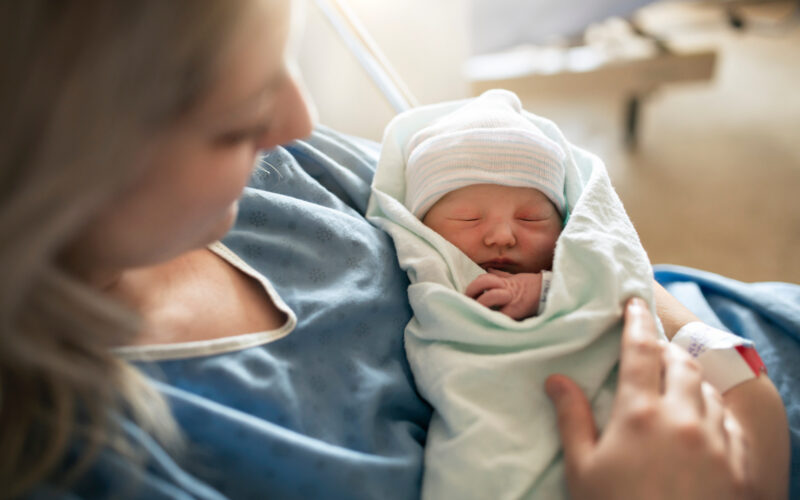After a couple of hours of serious labor with my daughter, I remember telling my husband over and over, “I’m sorry, I know we wanted more kids, but I can’t do this again!” As I write this, I’m just a few weeks away from delivering my third child (and we’re very excited!). Naturally, my husband didn’t take anything I said in the throes of labor too seriously.
Birth is an intense experience that can range from hard to downright traumatic. Exhaustion and high emotion don’t lend themselves to the careful consideration necessary to make important decisions. And yet, there are a lot of decisions that need to be made in the hours and days after birth. In general, these decisions (mostly regarding the newborn) can be researched beforehand. But one decision moms might not anticipate is whether or not to get a long-acting reversible contraceptive (LARC) injected or inserted before they even leave the hospital.
What does LARC placement postpartum look like?
LARCs refer to intrauterine devices (IUDs), which may be the copper IUD or the levonorgestrel-IUD, the Depo Provera birth control shot, and the contraceptive arm implant (known most commonly in the U.S. as Nexplanon).
An IUD or implant can be placed immediately after the placenta is delivered. According to a 2018 review in the journal Obstetrics & Gynecology, there is a small window of time for an IUD to be placed in the immediate postpartum period to lower the risk of accidental expulsion (i.e. the IUD falls out). IUDs placed less than 10 minutes after placental delivery had an expulsion rate of 10% compared to the 29.7% expulsion rate for IUDs placed after 10 minutes and up through four weeks postpartum. Women who allowed their uterus time to heal and contract back to its normal size (approximately four or more weeks postpartum) before having an IUD placed experienced only a 1.9% expulsion rate.
What are the benefits of immediate postpartum LARC placement?
From a medical provider standpoint, there are practical benefits to encouraging immediate LARC placement. Some providers may see the delivery room as their best or only opportunity to offer contraception to women, especially women unlikely to receive postpartum care or who may resume sexual activity before a six-week follow-up appointment.
Also, according to a fact sheet for an Illinois initiative promoting immediate post-delivery LARC placement, “LARC methods help prevent short-interval pregnancy. In Illinois (2011-2016), 29% of pregnancies were conceived within 18 months of delivery. Short interval pregnancies are associated with adverse outcomes for moms and babies including preterm birth, low birth weight, and preeclampsia.”
This is the biggest issue with postpartum LARC placement
We’ve previously challenged claims that “Short-interval pregnancies,” i.e., a child conceived less than 18 months after a previous child’s birth—which postpartum LARC insertion could potentially mitigate—always lead to worse outcomes for moms and babies. But the most important issue with LARC placement postpartum is this: if a woman has not been given time to make a thoughtful and informed decision beforehand, there is a serious ethical concern for providers who try to elicit consent for LARC placement during labor or immediately after birth.
Special concerns for LARC use immediately postpartum
The postpartum period is an important time of healing. Labor and delivery take a serious toll on the body, and taking time to rest in the weeks following birth is already made more complicated by the demands of caring for a newborn. According to the American College of Obstetricians and Gynecologists (ACOG), common LARC side effects include breast tenderness, headaches, nausea, mood changes, and increased bleeding. These are symptoms that may already be a burden postpartum and thus worsened by contraceptive use. IUDs may also irritate the uterus, which is still healing from the dinner plate-sized wound created when the placenta detaches. And, while LARCs are generally considered safe for breastfeeding, different people respond to contraception differently, and there is no guarantee that milk supply will be unaffected.
According to the American College of Obstetricians and Gynecologists (ACOG), common LARC side effects include breast tenderness, headaches, nausea, mood changes, and increased bleeding. These are symptoms that may already be a burden postpartum and thus worsened by contraceptive use.
While rare, there are also dangerous risks that come with IUDs and implants. According to ACOG, these risks include uterine perforation and ectopic pregnancy (with an IUD), and device migration to different parts of the body (as with Nexplanon).
As mentioned above, the most common complication of placing “postplacental” IUDs, meaning right after the placenta is delivered, is the risk of expulsion. A small study from 2011 found the expulsion rate to be 38% when IUDs were inserted 6 hours after birth [3]. 2023 research suggests that levonorgestrel-IUDs (LNG-IUDs) have a higher rate of accidental expulsion than copper-IUDs [2].
LARC use and postpartum depression
One dangerous side effect of particular concern for postpartum moms is the increased risk of depression that accompanies contraceptive use, since approximately 1 in 7 women already struggle with postpartum depression (PPD). A 2018 review that investigated adverse side effects reported to the FDA identified that levonorgestrel-IUDs and hormonal contraceptives seem to be associated with an increased risk of PPD [4]. Overall, however, there is limited, and often conflicting, research available that investigates the association between LARCs and postpartum depression specifically. But, as LARC use and PPD have both been on the rise in recent years (a 2023 study by Kaiser Permanente reports a 105% increase in PPD between 2010 and 2021), more research will hopefully be conducted on LARC impacts and other factors that may be contributing to this increase [5].
It is also possible that LARC use can contribute indirectly to feelings of depression. LARCs are associated with breast tenderness and, anecdotally, with decreased milk supply, and difficulties with breastfeeding are a definite risk factor for PPD. Symptoms that increase physical discomfort in the postpartum period, such as headaches, nausea, and heavy bleeding can all make it difficult to sleep (already in short supply!), relax, meet the nutritional demands of healing and breastfeeding, and bond with your baby. Recovering from birth is a big job and factors that make this job any more difficult than it needs to be can all contribute to depressive symptoms.
While placing an IUD or an implant immediately after birth appears to be a convenient option for providers and new moms alike, it’s one that comes with side effects, expulsion risk, and the ethical consideration of being an important medical decision that takes place immediately after birth.
Furthermore, the risks that come with getting a LARC immediately after birth or in the six to eight weeks after birth may very well be to prevent ovulation that was never going to occur in this time period, anyway! While an early return to fertility postpartum certainly does happen for some women, a 2011 study found that the majority of nonlactating women will not ovulate for the first time again until 6 weeks postpartum. For other women, this shift may not take place for months (and perhaps even a year or more!), especially if any amount of breastfeeding or pumping is taking place.
While an early return to fertility postpartum certainly does happen for some women, a 2011 study found that the majority of nonlactating women will not ovulate for the first time again until 6 weeks postpartum.
Women can use fertility awareness even before their periods return to look for signs of returning fertility. Working to understand the body instead of highjacking its hormones mere minutes after giving birth can set women up better for healing postpartum all while avoiding the uncomfortable, and potentially dangerous, side effects of contraception.
This is where we should be focusing our postpartum care attention instead
Perhaps the most vital initiative we can pursue to help moms and their new babies isn’t to insert IUDs or implants into them mere moments or hours after they’ve welcomed a new human being into the world. Perhaps it’s to improve access to postpartum care, as advocated by an alternative initiative for religiously affiliated hospitals in Illinois (who would not be participating in the initiative to provide postpartum LARCs).
A 2018 ACOG position paper recommended “that all women have contact with their obstetrician–gynecologists or other obstetric care providers within the first 3 weeks postpartum.” 6 years later, this is still far from reality for the vast majority of U.S. women. The Illinois initiative requires participating hospitals to schedule a 2-week follow-up appointment before the woman leaves the hospital.
That 2-week checkup should include “blood pressure evaluation, wound/perineum check, mental health well-being check, breastfeeding support, discussion of pregnancy spacing and family planning options, as well as follow-up for any medical/pregnancy complications with linkage to indicated referrals and community services (i.e., WIC, home visiting programs, lactation support groups, Substance Use Disorder treatment and support).”
This is precisely the kind of authentic postpartum support we at Natural Womanhood can get behind, increasing access to appropriate, timely care for both women and their babies—actual care that goes beyond the current standard of “Here’s your baby and your birth control. Good luck!” that far too many women leave the hospital with today.
Additional Reading:
Is birth control safe while breastfeeding?
Can you really use breastfeeding as natural birth control
The Unethical Push to Sterilize Women in the Delivery Room
References:
[1] Jatlaoui, Tara C. MD, MPH; Whiteman, Maura K. PhD; Jeng, Gary PhD; Tepper, Naomi K. MD, MPH; Berry-Bibee, Erin MD, MPH; Jamieson, Denise J. MD, MPH; Marchbanks, Polly A. PhD; Curtis, Kathryn M. PhD. Intrauterine Device Expulsion After Postpartum Placement: A Systematic Review and Meta-analysis. Obstetrics & Gynecology 132(4):p 895-905, October 2018. | DOI: 10.1097/AOG.0000000000002822







